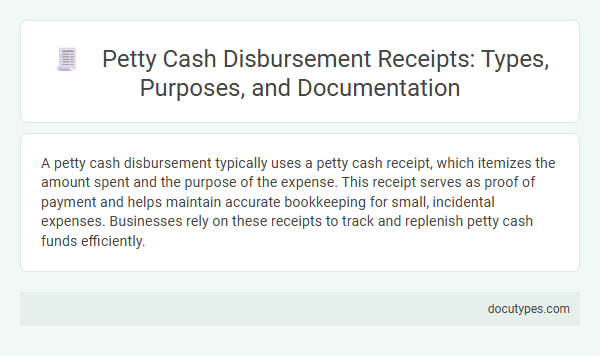A petty cash disbursement typically uses a petty cash receipt, which itemizes the amount spent and the purpose of the expense. This receipt serves as proof of payment and helps maintain accurate bookkeeping for small, incidental expenses. Businesses rely on these receipts to track and replenish petty cash funds efficiently.
Introduction to Petty Cash Disbursement Receipts
What type of receipt is used for petty cash disbursements? Petty cash disbursement receipts are typically simple vouchers that document small business expenses. These receipts provide a clear record of each transaction, ensuring proper tracking and accountability for your petty cash fund.
Understanding Petty Cash Systems
Petty cash disbursements are typically documented using petty cash vouchers or receipts. These receipts provide a clear record of small, everyday business expenses paid from the petty cash fund.
A petty cash system involves setting aside a small amount of money for minor expenditures to streamline expense management. Using standardized petty cash receipts helps maintain accurate tracking and accountability within the system.
Common Types of Petty Cash Disbursement Receipts
Petty cash disbursement receipts are essential for tracking small, day-to-day expenses within a business. You should use a receipt type that clearly documents each transaction to maintain accurate financial records.
- Standard Petty Cash Receipt - A simple form capturing the date, amount, and purpose of the disbursement.
- Imprest System Receipt - Used to record expenses that replenish the fixed petty cash fund regularly.
- Voucher Receipt - Combines authorization and proof of payment to ensure proper approval and documentation.
Key Purposes of Petty Cash Disbursement Receipts
Petty cash disbursements use a petty cash receipt specifically designed to document small, routine expenditures. These receipts capture essential information such as the amount spent, date, purpose of the expense, and the individual receiving the funds. The key purpose of petty cash disbursement receipts is to maintain accurate financial records, ensure accountability, and facilitate expense tracking within an organization.
Essential Elements of a Petty Cash Receipt
A petty cash receipt is a simple, yet detailed document used to record small cash disbursements from the petty cash fund. It ensures transparency and accurate tracking of minor expenses within a business.
- Date of Transaction - Records the exact date when the petty cash disbursement occurred to maintain chronological accuracy.
- Amount Disbursed - Specifies the exact cash amount given for accountability and reconciliation purposes.
- Purpose or Description - Details the reason for the disbursement to justify the expense within company records.
A properly completed petty cash receipt supports financial control and simplifies expense auditing.
Procedures for Issuing and Recording Disbursements
| Type of Receipt | Petty Cash Voucher |
|---|---|
| Purpose | Documenting small, miscellaneous cash disbursements from the petty cash fund |
| Issuing Procedure |
|
| Recording Procedure |
|
| Key Benefits |
|
Documentation Requirements for Petty Cash Receipts
Receipts for petty cash disbursements must provide clear documentation to ensure accurate financial tracking. Proper petty cash receipts support accountability and help prevent discrepancies in cash handling.
- Detailed Receipt Information - Receipts should include the date, amount spent, and a clear description of the purchase or expense.
- Authorized Signatures - Each petty cash receipt requires approval or a signature from the individual responsible for the disbursement to verify legitimacy.
- Supporting Documentation - Retain original receipts or invoices attached to petty cash vouchers for audit and record-keeping purposes.
Best Practices for Managing Petty Cash Receipts
Petty cash disbursements typically use simplified receipts known as petty cash vouchers. These receipts document the date, amount, purpose, and recipient of each transaction to ensure accurate tracking.
Best practices for managing petty cash receipts include maintaining a dedicated petty cash log to record every voucher issued. Each receipt should be reviewed and approved by authorized personnel to prevent misuse. Regular reconciliations between vouchers and cash on hand help maintain transparency and accountability within the petty cash fund.
Audit and Compliance Considerations
A petty cash voucher receipt is commonly used for petty cash disbursements as it documents the amount spent and the purpose. This type of receipt supports audit trails by providing clear evidence of expenses, ensuring transparency and accountability. Properly maintained petty cash receipts help organizations comply with internal controls and financial regulations.
What Type of Receipt Is Used for Petty Cash Disbursements? Infographic

